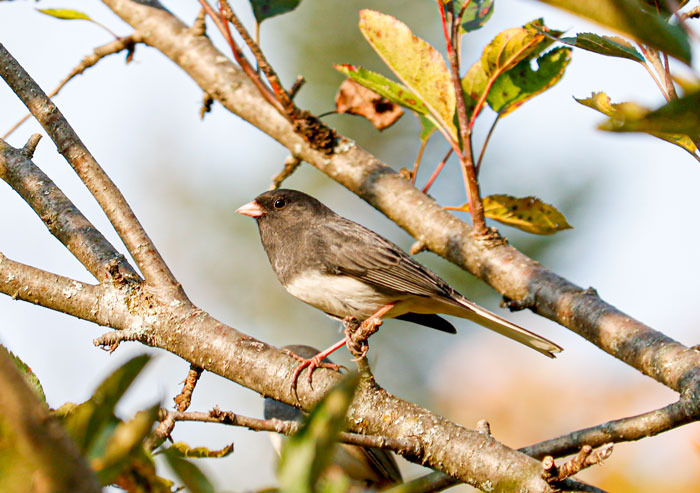
The dark-eyed juncos (Junco hyemalis) usually show up around late summer into early fall. These birds are considered a year-round resident here in Maine but will migrate farther north during the breeding season. This winter, I have noticed a lot more of this species coming to my feeders. They have been the first visitors to show up in the morning and the last to leave in the evenings. These birds are known to flock under bird feeders to enjoy fallen seeds, but my visiting juncos haven’t been shy at all about getting right into the feeders. I have also noticed they have taken up residence in the far corner of the yard among the pine trees. I enjoy observing these birds throughout the fall and winter and I’ll be sad to see them go, as they will be leaving to go up north in the spring. I suppose I can find comfort in regard to the cyclical nature of things.
Information About the Dark-eyed Junco
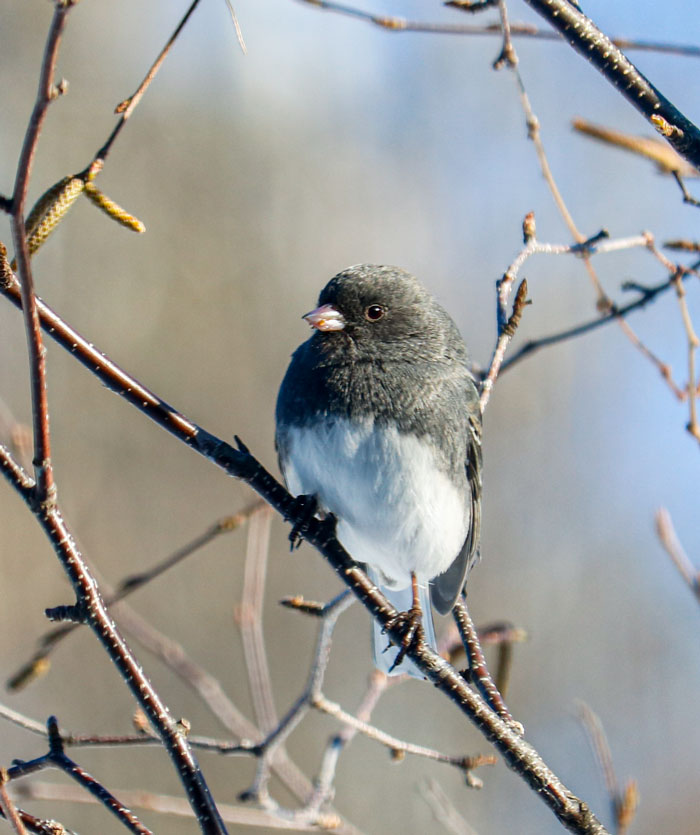
Dark-eyed juncos are one of the most common birds in North America. Juncos prefer semi-open areas of woods, undergrowth, roadsides, and brush. Breeding habitat is consistently in coniferous or mixed woodland areas. During the winter and migration, they use a wider variety of habitats including open woodlands, fields, roadsides, backyards, parks, and gardens.
Description of the Dark-eyed Junco
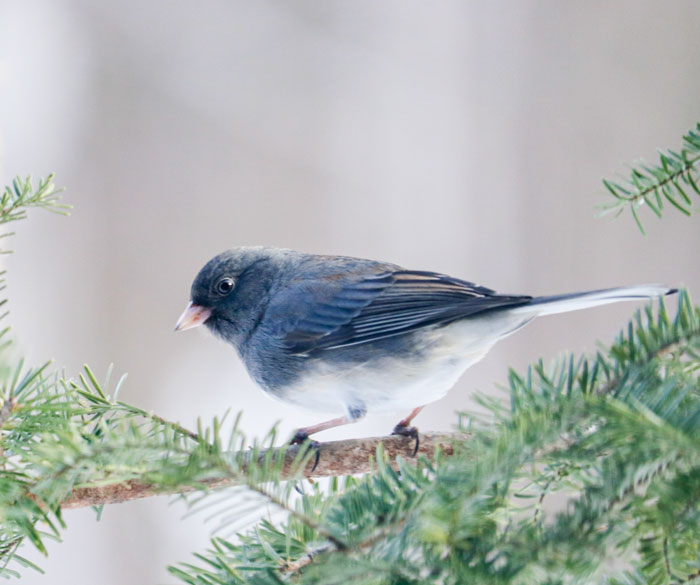
The Dark-eyed junco is a medium-sized sparrow with a rounded head, with a short, stout bill and a fairly long, visible tail.
There are regional differences in the appearance of juncos, but in general, these birds are dark gray or brown in color. They have white outer tail feathers that can be seen more easily during flight.
Dark-eyed Junco Behavior & Diet
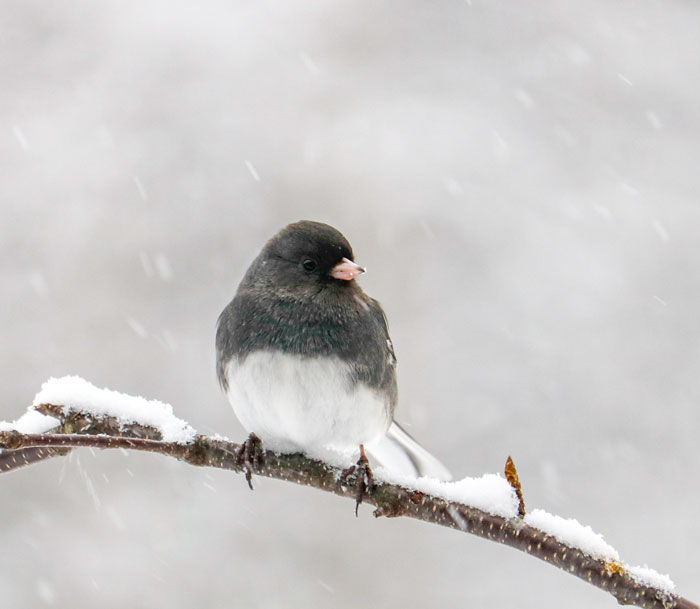
Dark-eyed Juncos are primarily ground birds. You can find them hopping and running around the bases of trees and shrubs in the woods or venturing out onto lawns looking for fallen seeds. They sometimes scratch with their feet in leaf-litter or snow. They will come to bird feeders but tend to forage on the ground underneath feeders. You can often hear their high chip notes. They almost do this absent-mindedly while foraging, or intensifying as they take short, low flights through the cover.
Juncos mostly feed on seeds and insects. During the summer, close to half of their diet consists of insects, including caterpillars, beetles, grasshoppers, true bugs, and others as well as spiders. In the winter, these birds will feed heavily on weeds and grasses. They will also sometimes eat berries and young feed primarily on insects.
Dark-eyed Junco Call & Song

Dark-eyed juncos have a high, short chip note. This occurs frequently during flight and slows down while foraging. You can also hear juncos give a high, fast twittering call of six to nineteen notes during noisy quarrels or as birds flush.
Males sing an even, musical trill of seven to twenty-three notes that will last up to two seconds. Their song is similar to that of the chipping sparrow (Spizella passerina) and the pine warbler (Setophaga pinus). The song is very loud and can be heard from several hundred feet. Both sexes will song a mush quieter song as well. This entails a series of whistles, trills, and warbles that can sound like an American goldfinch (Spinus tristis).
Dark-eyed Junco Breeding & Nesting
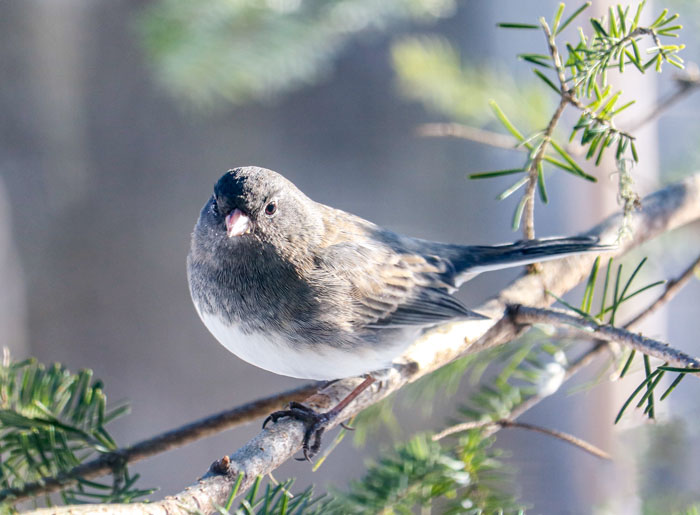
Nesting sites are almost always on the ground, well hidden under overhanging grass, under logs, rocks, or exposed roots, or located in a shallow hole in a dirt bank. Nests can sometimes be constructed up in a shrub, tree, or ledge of building, rarely more than ten feet above the ground. Nests are mostly built by females and consist of an open cup of grass, weeds, leaves, lined with fine grass and sometimes with hair or feathers.
There are three to five eggs bluish white or pale gray, with brown and gray markings often concentrated at larger end. Incubation is done by the female, for about eleven to thirteen days. Both parents feed the nestlings. Young will leave the nest nine to thirteen days after hatching. They will have one to two broods per year and sometimes even three.
Dark-eyed Junco Migration
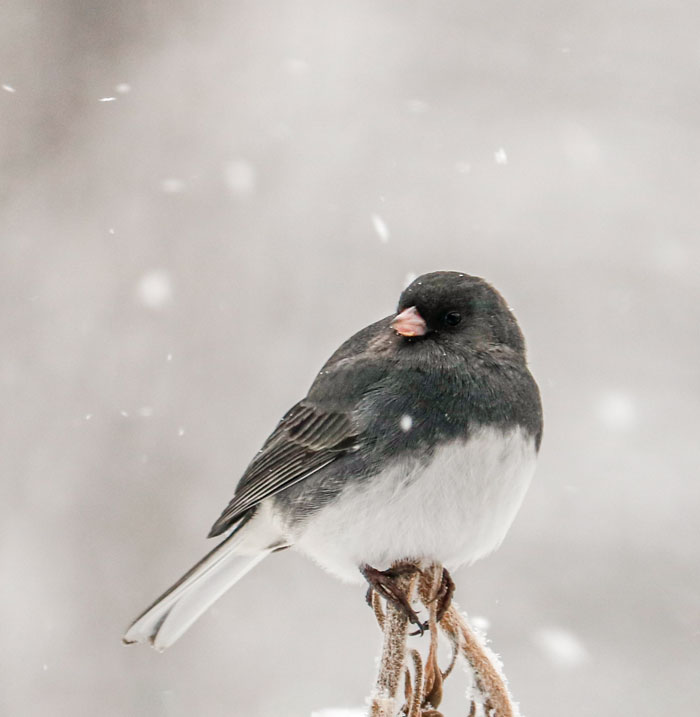
Dark-eyed juncos are described as being resident to medium-distance migrants. Juncos that breed in Canada and Alaska will migrate to the southern U.S. during the winter months. Some Rocky Mountain populations are only short-distance migrants. Individuals in the West and in the Appalachian Mountains of the East do not migrate at all.
Thank you for reading and I hope you enjoyed learning a little about the dark-eyed junco.
Resources used for this post:
allaboutbirds.org & audubon.org
I’ve got 2 pairs of Juncos in my back yard. It’s almost the middle of april. Any idea as to why they havent left yet? The rest have already went north. I live in southwestern Indiana.
Hi Nan,
I’m not sure why they are exhibiting this type of behavior. Your juncos must find the current conditions in your area optimal but may move on eventually. Here is Cornell’s range map for you to look at:
https://www.allaboutbirds.org/guide/Dark-eyed_Junco/maps-range
Although the majority of dark-eyed junco have left, I also have a couple hanging around my yard and feeders. I’m sure they will move on in the coming weeks.
Please let me know if your juncos move on or if you have any more questions.
Thank you,
Laura